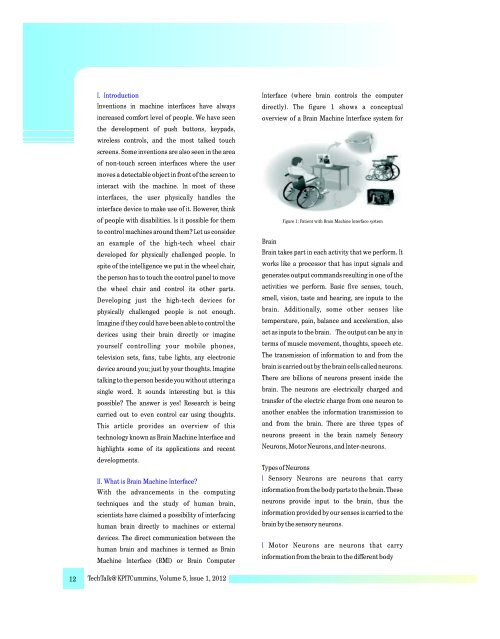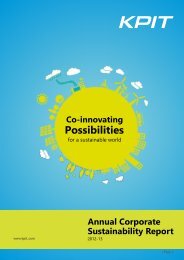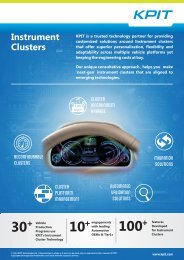INNOVATIONS FROM THE EDGE - KPIT
INNOVATIONS FROM THE EDGE - KPIT
INNOVATIONS FROM THE EDGE - KPIT
Create successful ePaper yourself
Turn your PDF publications into a flip-book with our unique Google optimized e-Paper software.
I. Introduction<br />
Inventions in machine interfaces have always<br />
increased comfort level of people. We have seen<br />
the development of push buttons, keypads,<br />
wireless controls, and the most talked touch<br />
screens. Some inventions are also seen in the area<br />
of non-touch screen interfaces where the user<br />
moves a detectable object in front of the screen to<br />
interact with the machine. In most of these<br />
interfaces, the user physically handles the<br />
interface device to make use of it. However, think<br />
of people with disabilities. Is it possible for them<br />
to control machines around them Let us consider<br />
an example of the high-tech wheel chair<br />
developed for physically challenged people. In<br />
spite of the intelligence we put in the wheel chair,<br />
the person has to touch the control panel to move<br />
the wheel chair and control its other parts.<br />
Developing just the high-tech devices for<br />
physically challenged people is not enough.<br />
Imagine if they could have been able to control the<br />
devices using their brain directly or imagine<br />
yourself controlling your mobile phones,<br />
television sets, fans, tube lights, any electronic<br />
device around you; just by your thoughts. Imagine<br />
talking to the person beside you without uttering a<br />
single word. It sounds interesting but is this<br />
possible The answer is yes! Research is being<br />
carried out to even control car using thoughts.<br />
This article provides an overview of this<br />
technology known as Brain Machine Interface and<br />
highlights some of its applications and recent<br />
developments.<br />
II. What is Brain Machine Interface<br />
With the advancements in the computing<br />
techniques and the study of human brain,<br />
scientists have claimed a possibility of interfacing<br />
human brain directly to machines or external<br />
devices. The direct communication between the<br />
human brain and machines is termed as Brain<br />
Machine Interface (BMI) or Brain Computer<br />
Interface (where brain controls the computer<br />
directly). The figure 1 shows a conceptual<br />
overview of a Brain Machine Interface system for<br />
Figure 1: Patient with Brain Machine Interface system<br />
Brain<br />
Brain takes part in each activity that we perform. It<br />
works like a processor that has input signals and<br />
generates output commands resulting in one of the<br />
activities we perform. Basic five senses, touch,<br />
smell, vision, taste and hearing, are inputs to the<br />
brain. Additionally, some other senses like<br />
temperature, pain, balance and acceleration, also<br />
act as inputs to the brain. The output can be any in<br />
terms of muscle movement, thoughts, speech etc.<br />
The transmission of information to and from the<br />
brain is carried out by the brain cells called neurons.<br />
There are billions of neurons present inside the<br />
brain. The neurons are electrically charged and<br />
transfer of the electric charge from one neuron to<br />
another enables the information transmission to<br />
and from the brain. There are three types of<br />
neurons present in the brain namely Sensory<br />
Neurons, Motor Neurons, and Inter-neurons.<br />
Types of Neurons<br />
l Sensory Neurons are neurons that carry<br />
information from the body parts to the brain. These<br />
neurons provide input to the brain, thus the<br />
information provided by our senses is carried to the<br />
brain by the sensory neurons.<br />
l Motor Neurons are neurons that carry<br />
information from the brain to the different body<br />
12 TechTalk@<strong>KPIT</strong>Cummins, Volume 5, Issue 1, 2012

















